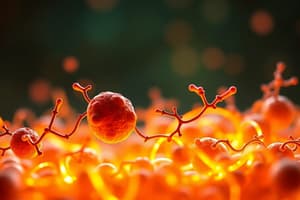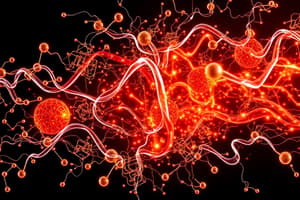Podcast
Questions and Answers
Flashcards
Metabolism
Metabolism
Sum of all chemical transformations in cells.
Bioenergetics
Bioenergetics
Study of energy transformations in biological systems.
Autotrophs
Autotrophs
Organisms that produce their own food from CO2.
Heterotrophs
Heterotrophs
Signup and view all the flashcards
Macromolecules
Macromolecules
Signup and view all the flashcards
Catabolism
Catabolism
Signup and view all the flashcards
Anabolism
Anabolism
Signup and view all the flashcards
Metabolic Pathway
Metabolic Pathway
Signup and view all the flashcards
Metabolites
Metabolites
Signup and view all the flashcards
Energy Transformation
Energy Transformation
Signup and view all the flashcards
Nitrogen Source
Nitrogen Source
Signup and view all the flashcards
Photosynthetic Organisms
Photosynthetic Organisms
Signup and view all the flashcards
Free Energy Loss
Free Energy Loss
Signup and view all the flashcards
Entropy Increase
Entropy Increase
Signup and view all the flashcards
Substrate Availability
Substrate Availability
Signup and view all the flashcards
Allosteric Regulation
Allosteric Regulation
Signup and view all the flashcards
Km
Km
Signup and view all the flashcards
Fatty Acid Synthesis
Fatty Acid Synthesis
Signup and view all the flashcards
Fatty Acid Catabolism
Fatty Acid Catabolism
Signup and view all the flashcards
Enzyme Regulation
Enzyme Regulation
Signup and view all the flashcards
Growth Factors
Growth Factors
Signup and view all the flashcards
Solar Energy
Solar Energy
Signup and view all the flashcards
Chemical Energy
Chemical Energy
Signup and view all the flashcards
Open systems
Open systems
Signup and view all the flashcards
Equilibrium
Equilibrium
Signup and view all the flashcards
Gibbs free energy (G)
Gibbs free energy (G)
Signup and view all the flashcards
Exergonic reaction
Exergonic reaction
Signup and view all the flashcards
Endergonic reaction
Endergonic reaction
Signup and view all the flashcards
Enthalpy (H)
Enthalpy (H)
Signup and view all the flashcards
Exothermic reaction
Exothermic reaction
Signup and view all the flashcards
Endothermic reaction
Endothermic reaction
Signup and view all the flashcards
Entropy (S)
Entropy (S)
Signup and view all the flashcards
ΔG equation
ΔG equation
Signup and view all the flashcards
Isothermal systems
Isothermal systems
Signup and view all the flashcards
Heterotrophic cells
Heterotrophic cells
Signup and view all the flashcards
Photosynthetic cells
Photosynthetic cells
Signup and view all the flashcards
Equilibrium constant
Equilibrium constant
Signup and view all the flashcards
Standard conditions
Standard conditions
Signup and view all the flashcards
Standard free energy change (ΔG'o)
Standard free energy change (ΔG'o)
Signup and view all the flashcards
Spontaneous reaction
Spontaneous reaction
Signup and view all the flashcards
Study Notes
Metabolism
- Sum of all chemical transformations in cells.
Bioenergetics
- Study of energy transformations in biological systems.
Autotrophs
- Organisms that produce their own food from CO2.
Heterotrophs
- Organisms that obtain nutrients from organic sources.
Macromolecules
- Large molecules like proteins and nucleic acids.
Catabolism
- Degradative phase converting nutrients into simpler products.
Anabolism
- Biosynthesis phase forming complex molecules from precursors.
Metabolic Pathway
- Series of enzyme-catalyzed reactions for specific changes.
Metabolites
- Products formed from precursors via metabolic pathways.
Energy Transformation
- Conversion of energy from one form to another.
Nitrogen Source
- Essential for amino acids and nucleotides synthesis.
Photosynthetic Organisms
- Use sunlight to convert CO2 into organic compounds.
Free Energy Loss
- Energy not available for work, often as heat.
Entropy Increase
- Measure of disorder in a system, increases over time.
Substrate Availability
- Immediate factor affecting enzyme activity and reaction rate.
Allosteric Regulation
- Enzyme activity modulated by metabolic intermediates or coenzymes.
Km
- Substrate concentration at which reaction rate is half-max.
Fatty Acid Synthesis
- Anabolic process converting acetyl-CoA into fatty acids.
Fatty Acid Catabolism
- Degradative process breaking down fatty acids for energy.
Enzyme Regulation
- Control of enzyme levels and activity in metabolism.
Growth Factors
- Substances that regulate metabolic activities in multicellular organisms.
Solar Energy
- Primary driving force for autotrophic and heterotrophic cycles.
Chemical Energy
- Energy stored in chemical bonds, released during metabolism.
Open systems
- Living cells exchange energy and materials with surroundings.
Equilibrium
- State where forward and reverse reaction rates equal.
Gibbs free energy (G)
- Energy available for work in a reaction.
Exergonic reaction
- Releases energy, ΔG is negative.
Endergonic reaction
- Absorbs energy, ΔG is positive.
Enthalpy (H)
- Heat content of a reacting system.
Exothermic reaction
- Releases heat, products have lower heat content.
Endothermic reaction
- Absorbs heat, products have higher heat content.
Entropy (S)
- Measure of disorder or randomness in a system.
ΔG equation
- ΔG = ΔH - TΔS relates energy changes.
Isothermal systems
- Cells maintain constant temperature during reactions.
Heterotrophic cells
- Obtain energy from nutrient molecules.
Photosynthetic cells
- Acquire energy from solar radiation.
Equilibrium constant
- Defined by concentrations of reactants and products.
Standard conditions
- 298K temperature, 1M concentrations, 1 atm pressure.
Standard free energy change (ΔG'o)
- Difference in free energy under standard conditions.
Spontaneous reaction
- Occurs when ΔG is negative.
Non-spontaneous reaction
- Occurs when ΔG is positive.
Actual free energy (ΔG)
- Free energy based on current concentrations.
Enzymes
- Catalysts that lower activation energy of reactions.
Covalent bonds
- Chemical bonds formed by shared electrons.
Nucleophiles
- Functional groups that donate electrons.
Electrophiles
- Functional groups that accept electrons.
Reaction types
- Includes carbon bond breaking, rearrangements, and redox.
Carbanion
- Nucleophilic species with a negatively charged carbon.
Carbocation
- Electrophilic species with a positively charged carbon.
Reaction Intermediates
- Unstable species formed during chemical reactions.
Carbonyl Groups
- Functional groups crucial for metabolic pathways.
Delocalization
- Spreading out of charge over multiple atoms.
Acid Catalyst
- Substance that increases reaction rate via proton donation.
Aldol Condensation
- Reaction forming C-C bonds, producing six-carbon compounds.
Claisen Ester Condensation
- Reaction involving thioester stabilization in citric acid cycle.
Decarboxylation
- Process forming ketone bodies during fatty acid metabolism.
Prenyltransferase
- Enzyme catalyzing condensation in cholesterol biosynthesis.
Isomerization
- Intramolecular rearrangement without changing oxidation state.
Cis-Trans Rearrangement
- Rearrangement altering spatial configuration of double bonds.
Homolytic Cleavage
- Breaking covalent bonds to form free radicals.
Adenosylcobalamin
- Vitamin B12 involved in isomerization reactions.
Ribonucleotide Reductase
- Enzyme catalyzing free radical reactions.
Group Transfer Reactions
- Transfer of functional groups between nucleophiles.
Acyl Transfer
- Transfer of acyl groups, e.g., in chymotrypsin reaction.
Glycosyl Transfer
- Transfer of sugar groups during nucleophilic substitution.
Phosphoryl Group Transfer
- Key in metabolic pathways, activating intermediates.
Good Leaving Group
- Group that easily departs during chemical reactions.
Oxidation States
- Carbon can exist in five distinct oxidation states.
Dehydrogenases
- Enzymes catalyzing biological oxidation reactions.
ATP Hydrolysis
- Reaction releasing energy through phosphate bond cleavage.
Standard Free Energy of Hydrolysis
- Energy change during ATP hydrolysis, -30.5 kJ/mol.
Phosphorylated Compounds
- Compounds with high or low phosphoryl group transfer.
Standard Free Energy
- Energy change during hydrolysis of compounds.
Catabolism
- Metabolic process focused on breaking down molecules.
High-Energy Phosphate Compounds
- Compounds that activate transformations in metabolism.
Thermodynamically Unstable ATP
- ATP readily breaks down to release energy.
Activation Energy
- Energy required to initiate a chemical reaction.
SN2 Nucleophilic Displacement
- Type of reaction ATP undergoes during transfers.
Nucleophilic Attack
- Reaction where nucleophiles attack electrophilic centers.
Adenylylation
- Transfer of adenylyl groups from ATP.
Fatty Acid Activation
- Process requiring ATP for fatty acid metabolism.
Nucleoside Triphosphates
- Building blocks for DNA and RNA synthesis.
Phosphoanhydride Linkage
- Bond between alpha and beta phosphates in ATP.
PPi Release
- Byproduct of polymerization reactions involving nucleotides.
Bioluminescence
- Light production via biochemical reactions, requires ATP.
Luciferin
- Biochemical compound activated to produce light.
Luciferase
- Enzyme catalyzing the reaction to produce light.
Biological Membranes
- Structures defining cell boundaries and controlling transport.
Selective Permeability
- Membranes allow specific substances to pass through.
Fluid Mosaic Model
- Describes the dynamic structure of biological membranes.
Glycoproteins
- Proteins with oligosaccharides affecting stability and function.
Membrane Thickness
- Biological membranes are 50-80 Å thick.
Asymmetric Protein Orientation
- Proteins in membranes have specific functional arrangements.
Lateral Diffusion
- Movement of proteins and lipids within the membrane.
Lipids
- Insoluble in water, form aggregates in membranes.
Hydrophobic interactions
- Driving force for bilayer formation and stability.
Micelles
- Spherical lipid structures with head > tail area.
Bilayers
- Two monolayer leaflets create a membrane sheet.
Vesicles
- Closed lipid structures with no exposed hydrophobic ends.
Integral membrane proteins
- Firmly attached proteins requiring detergents for removal.
Studying That Suits You
Use AI to generate personalized quizzes and flashcards to suit your learning preferences.




